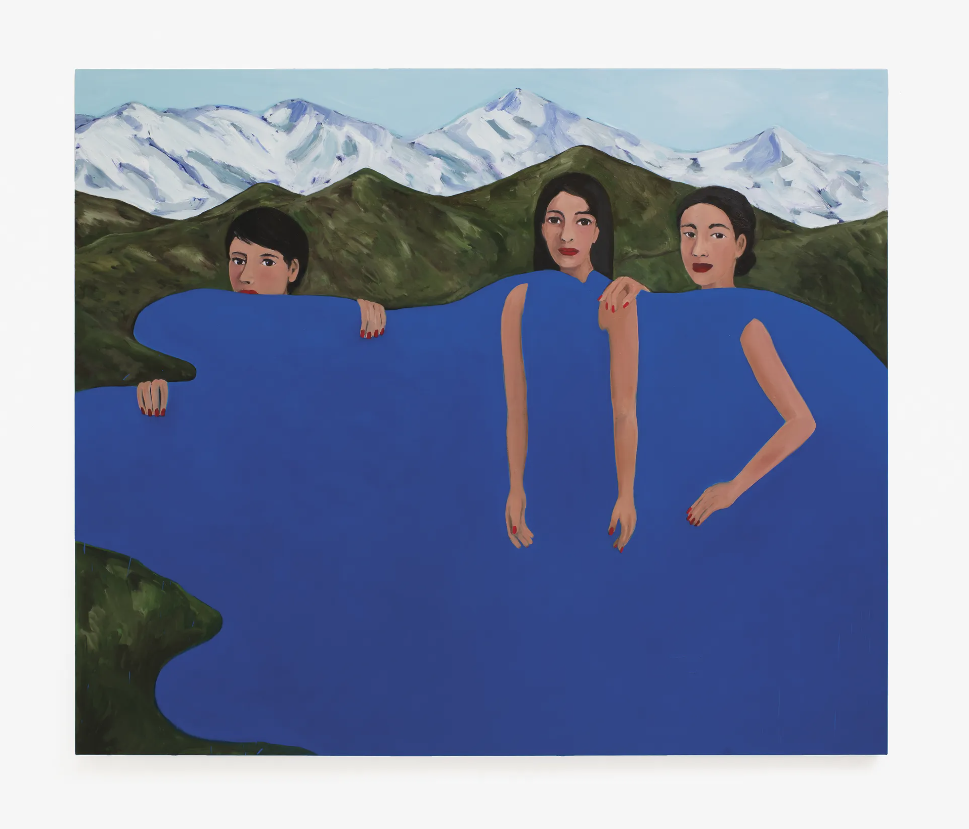
- Source: VOGUE
- Author: DODIE KAZANJIAN
- Date: FEBRUARY 15, 2019
- Format: ONLINE
As Frieze Los Angeles Opens, Three Young California Artists Are Reinventing What Figurative Painting Can Be

“My goal was to use the figure in a way I hadn’t seen before,” says Becky Kolsrud, 34. Three Women, 2017. Photo: Becky Kolsrud. Three Women, 2017. Oil on canvas, 76″ x 90″. Courtesy of the artist and JTT, New York. Photograph: Charles Benton.
As the international art fair Frieze makes its first appearance in Los Angeles, the stalls are packed with people—not just the crowds that streaming into the Paramount Pictures lot but on the canvases as well. No city captures the current drive toward figurative painting with more diversity and élan than Los Angeles. The work is often narrative—connecting, perhaps to the town’s industry—but can also be surreal. “It’s an escape,” says independent curator Ali Subotnick, who organized the project section for the inaugural edition of Frieze Los Angeles. “It’s a way to have some control when you have no control over what’s happening in this chaotic world we’re living in.”
If the southern California city has become the launch site for a new movement of body-oriented painters, its representatives have been drawn from all over the globe. Njideka Akunyili Crosby explores her Nigerian family history in domestic settings that bridge two cultures. Iranian-born Tala Madani likes to give men the finger in her cartoonish, hilarious, and disturbing paintings and animations. Latvian artist Ella Kruglyanskaya throws female bodies together in aggressive combinations. And then there’s German-born Katja Seib, who trained with Tomma Abts and was a visiting student of Peter Doig at the famed Arts Academy of Düsseldorf. Her lucid, moody figure paintings, on rough burlap or found fabrics, mix realism and fiction in unexpected ways—one just made its L.A. debut in Sadie Coles’s booth at Frieze.
There are also plenty of homegrown artists, like Christina Quarles, whose sinuous, long-legged forms exuberantly romp and intertwine in colorful domestic surroundings from which they may be struggling to escape. (Quarles and Celeste Dupuy-Spencer, another Angeleno, were both featured in the Hammer Museum’s “Made in L.A.” biennial last summer.) Becky Kolsrud, whose great-grandparents migrated from Japan to L.A., does surrealistic portraits of imaginary women. A host of scrappy new galleries are sprouting up to work with the influx of young artists: Château Shatto (where Seib’s first L.A. show opens this September) and Jenny’s and Freedman Fitzpatrick and Night Gallery and Various Small Fires. These galleries can take risks and go out on limbs that larger, more established galleries won’t touch.
Not that the bigger names have remained oblivious to L.A.’s figurative boom. Forced out as director of L.A.’s Museum of Contemporary Art in 2013, Jeffrey Deitch bounced back with his own gallery last September, a 15,000-square-foot showcase in Hollywood. “Unrealism,” the big new group show he’s been developing for 2020, will trace the new approaches to painting the figure and include many of the young L.A.-based groundbreakers. “The unifying theme,” Deitch tells me, “is that conventional realism cannot depict contemporary reality, where fact and fiction are confused.” A fitting subject for the city where dreams are made.
Here’s what three young L.A. figurative painters have to say about their work and how it relates to their city.
Becky Kolsrud
“I feel that L.A. has become more of a painter’s city in the past five or ten years. My goal was to use the figure in a way I hadn’t seen before in the canon of art history, using images of women that were familiar in advertising.
My last show was called ‘Allegorical Nudes.’ There are so many incredible bather paintings, and so often the vantage point is peeking through on a scene of women who don’t know you’re looking at them. I wanted to create paintings that felt more within my own world, with images of women of my time who gaze out of the picture, women who are not sexualized, women who pose with a sense of confidence. They know they’re being seen—you’re not catching them off guard.
“Painters are drawn to L.A. because of the light, just as the filmmakers were. Walking down the street to my studio, I see graffiti, garbage, broken-down cars, and parking lots. But then I look up and see purple snow-capped mountains. The landscape is this combination of beautiful and ugly, natural and urban, and that really is a good space for painters to be.”

